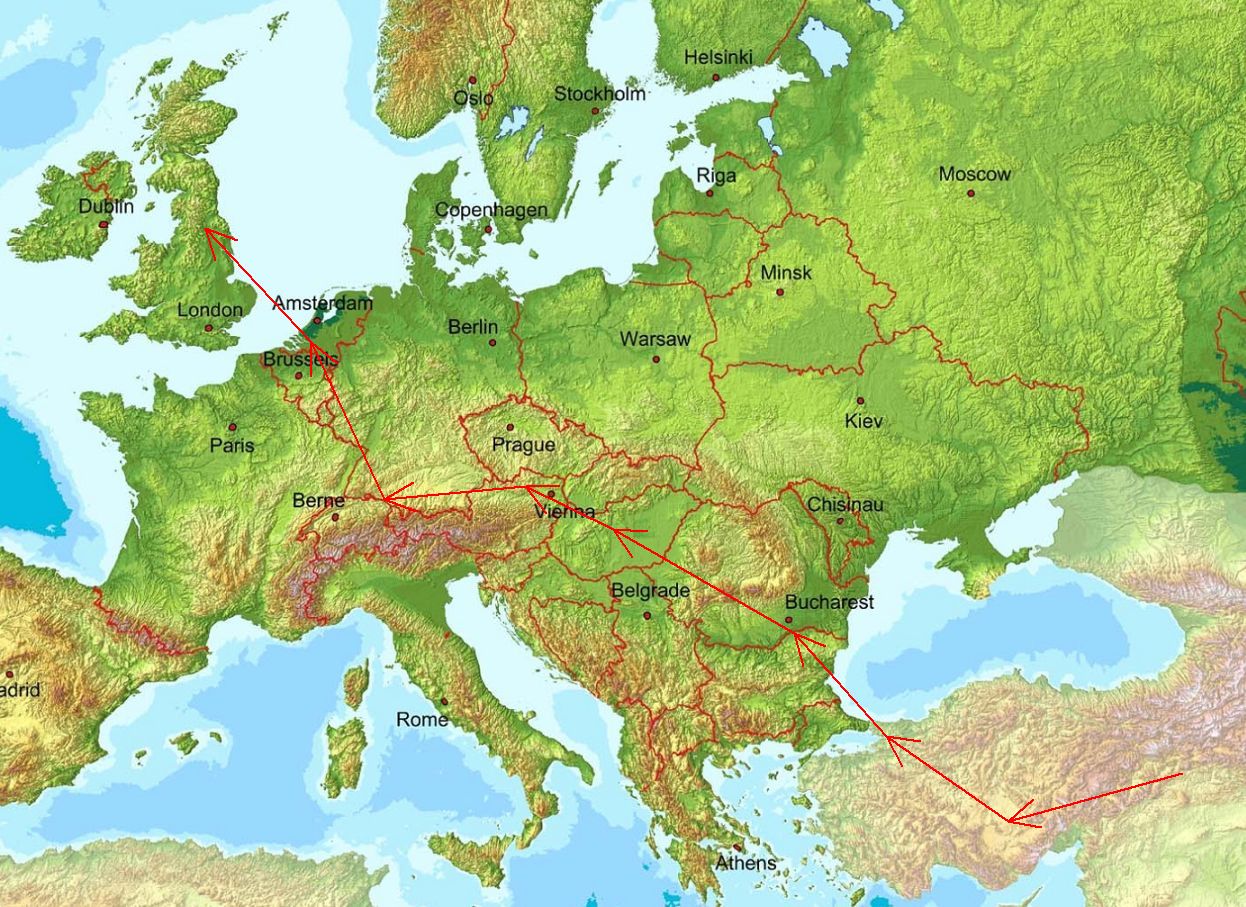 |
The Hissem-Montague Family  |
 |
The Hissem-Montague Family  |

On a previous page, Origin of a Family: Y-DNA, we left my father-line history at the beginning of the Bronze Age, circa 3,000 BC. Our paternal ancestors were probably farming a small plot somewhere in Central Europe. They would have lived in a nearby village that was protected by ditches and earthen walls; it could be an unfriendly world and there were no policemen about. While Neolithic farmers had successfully spread agriculture across Europe, they had, over the last few centuries, come into a decline. This was probably climate related (isn't everything?); a warmer, drier environment led to crop failure, famine, and a declining population.
At this point an invasion of riders out of the Pontic steppe of today's Russia and Ukraine arrived. They too may have been affected by a changing climate, riding west to find new pastures. These men were predominantly haplogroups R1a/R1b. The G2a population was overwhelmed and pushed off their farms on the bottom land. They subsequently sought sanctuary in the highlands. What happened to them over the succeeding centuries is not clear, but this was a cataclysm for the Neolithic farmers which resulted in a near-total replacement of the male population in Europe. Whereas haplogroup G had defined 50% or more of the male population in Central Europe during the Neolithic, today the percentages are from just 5% to 7.5% Many of the farmers were probably killed defending their homes and villages from the invaders, others were enslaved, yet others later starved when crops failed in the poor soil of their new uplands farms, while succeeding G2a generations may never have been born because the wives and daughters of the farmers were taken by the invaders.
"Neolithic farming migration into Europe "was driven by mass migration of both males and females in roughly equal numbers, perhaps whole families," while Bronze Age Pontic steppe "migration and cultural shift were instead driven by male migration, potentially connected to new technology and conquest." - from "Familial Migration of the Neolithic Contrasts Massive Male Migration during Bronze Age in Europe Inferred from Ancient X Chromosomes" by Goldberg et alIn contrast to the devastation experienced by G2a men there is strong evidence for genetic continuity in female haplogroup lineages.
A caveat: I have to observe that 20th century despots, despite access to the most advanced industrial technology and military armaments, had a difficult time exterminating entire races, so it seems unlikely that the new Steppe arrivals could have done so with only slightly better weapons technology than the farmers. In a corrective to the catcylsmic vision above, I note the comment below from the eupedia.com site.
"If for example in year 0 the R1b immigrant men were 10% of the males, and then they conquered the region and had a 4x higher reproductive success (e.g. 0.4% per year versus 0.1%) for many social, economic, cultural, demographic (emigration, fertility rate etc.) and even criminal reasons (including killings, why would you think that didn't happen often?), 1000 years later the R1b men would amount to 69% (yes!!!) of the regional male population."So, the reason the G2a population decreased so dramatically in the Bronze Age may have been because, as a now low-status population, call them beta-males, they could not compete effectively in the propagation market.
Another possibility is that some aspect of the R1a/b Y-DNA provided a reproductive advantage denied to their G2a brethren. It is interesting that some Y-DNA groups so dominate the human population, while others have had such a minor impact. Was this social or biological?
I don't see the Neolithic decline as epidemic related, though this is a popular claim. It is true, of course, that a Neolithic lifestyle did make people more susceptible to plague; extensive trade networks provided conduits for disease transmission and large, dense town-centered populations facilitated the rapid-fire spread of plagues. However, in a disease scenario mtDNA haplogroups should have shared equally in the Neolithic population decrease, which they did not.
For the surviving population I see four alternative scenarios that could eventually get our G2a-L497 haplogroup to the British isles in significant enough numbers.
(1) Neolithic Expansion. While there is now overwhelming evidence that agriculture was introduced into Britain by migrating continental farmers, they have been identified as Iberian, not central European. So far, all of the Neolithic remains discovered in England have proven to be haplogroup I2a. Yet undiscovered remains may include G2a, but if it existed it would most likely have been of the M406 sub-clade that defined the southern route into Europe. There is no evidence that G2a-L497, our family type, entered Britain during or before the Neolithic. I discussed this on the Origin of a Family page. I will revisit this option if new data becomes available.
(2) Bronze/Iron Age Expansion. Our ancestors may have hidden from the horse-borne invaders for a time in the Alpine valleys of the Tyrol and Switzerland, where the haplogroup is still most common. Then, in later centuries, when things had calmed down a bit, they might have safely descended out of the mountains, to be subsumed into the dominant culture. This may have been either the Bell Beaker, a trade culture of the Bronze Age, or the later Celtic Hallstatt and Le Tene of the Iron Age. Our ancestors might then have migrated into Britain identifying as members of one of these groups. I will address both of these scenarios below.
(3) Roman Expansion. The G2a-L497 population that found refuge in the Alps may have remained in place until the historical period when the Roman Empire subdued their homeland. They would have found their way to the Roman province of Britannia as soldiers, merchants or administrators of the Empire. A variation on this scenario is that our ancestors in the Alps moved south into Italy during the Bronze Age as part of the groups that founded the Villanovan and later Etruscan civilizations. Northern Italy today still shows a high percentage of G2a-L497. However, the Etruscans were also conquered by Rome and would have followed a path into Britain similar to that already discussed. I will address both of these scenarios on the Roman Origins page.
(4) Post-Roman Expansion. Migrations into Britain subsequent to the Roman withdrawal from Britain, circa 410 AD, were by northern Europeans, including the Angles, Saxons, Jutes, and Norwegian and Danish Vikings. The probability that they carried more than token numbers of G2a-L497 seems remote. [Note however two recent G2a-L497 remains in southern Sweden dated to the Viking Age]. The later Norman invasion, while predominantly of northern ancestry, may have included some Le Tene ancestry from the lower Seine. See the Norman Origins page for a discussion of this possibility.
| The Bronze Age
Bronze is created by alloying copper with tin, or arsenic, during the smelting process. This results in a metal harder and more durable than copper. This process was probably developed in the Near East, circa 3,300 BC. However, as with the preceding Copper Age, finds in Serbia show evidence of bronze smelting there at an earlier date, though this dating is disputed. The first writing systems, cuneiform and hieroglyphics, also date from this period. |
A succession of cultures emerged in Central Europe in the aftermath of the great R1a/R1b invasion. The first to emerge was the Corded Ware Culture 2,900-2,350 BC. This people possessed far fewer dwellings than their central European predecessors implying a semi-nomadic, pastoral lifestyle.
| Corded Ware Culture 3,100 BC - 2,350 BC
Theirs was a mobile pastoral economy with few settlements, relying mostly on cattle with occasional cereal cultivation. They were apparently a warlike people who made regular use of horses and oxe-drawn wagons (think of Tolkien's Wainriders out of the East). "On most of the immense, continental expanse that it covered, the culture was clearly intrusive, and therefore represents one of the most impressive and revolutionary cultural changes attested by archaeology." - from Wikipedia. Their Y-DNA was predominantly R1a & R1b with minorities of G2a, I1 & I2, and N1, legacies of earlier Paleolthic and Neolithic peoples. |
A few centuries later a trade culture, the Bell Beaker, arose across Europe west of the Elbe river. It complemented rather than replaced the Corded Ware. In their turn then arose the Unetice culture 2,300-1,600 BC, the Tumulus culture 1,600-1,200 BC, and the Urnfield culture 1,300-750 BC. However, there is no evidence of these cultures existant in the British Isles.
This era in British history spanned a period from circa 2,500 BC to about 800 BC, when the Iron Age began. In each of the cultures described below there were opportunities for small numbers of G2a males to enter England.
The Megalithic culture began during the Neolithic, circa 5,000 BC, and flourished until about 2,000 BC. It extended up the Atlantic coast from southern Spain to Brittany, and into southern England. The name derives from the monumental stones they erected, including at Stonehenge. There are some 900 stone circles and 40,000 megaliths surviving across the British Isles. A stone circle known as the Druid's Temple is at Birkrigg Common, in Cumbria, overlooking Morecombe Bay. Megalithic structures included the stone circle, the dolmen or portal tomb, the passage grave, the gallery grave or wedge tomb, and standing stones, known as menhirs in France.
Their Neolithic agricultural economy was based primarily on the cultivation of crops from the Fertile Crescent, especially wheat and barley. Megalithic farmers bred livestock, mostly cattle and sheep, but also, to a lesser extent, goats and pigs. Like in other Neolithic cultures, most tools were made of stone, bones and antlers. Flints and quarzes were used to make blades, cutters, scrapers and drills.
Ancient Y-DNA of the culture has been recovered for sites in Western continental Europe that yielded 64% I2a, 32% G2a, 1% CT, and 1% H. It is not unreasonable to expect that some of the G2a peoples of this southern culture would also reside across the channel in England, though none of their remains have yet been found there. However, if such remains are unearthed I would expect them to be of the G-M406 of Iberia, not the G-L497 of Central Europe.
The last centuries of the Megalithic culture in England were contemporaneous with the Bell Beaker trade phenomenon which connected the Atlantic economies to those of Central Europe. It is during this period that Steppe people carrying Y-haplogroup R1b migrated into western Europe replacing most of the Neolithic lineages in the region. While the Megalithic Culture survived in Britain, and in some ways thrived, the original Neolithic peoples who originated it did not.
I've come to believe that this is the likely moment when our Y-DNA ancestors crossed over from Europe to Britain. I base this on two things. First, that the G-Z726 subclade developed in Western Europe in about 2,600 BC, roughly contemporaneous with the expansion of the Bell Beaker culture in Europe, and, second, that the G-Z36217 subclade that derived from it, and which defines our Y-DNA group, developed in about 2,000 BC and is, so far, a wholly British clade. So, my theory is that some time between 2,600 and 2,000 BC our male-line ancestors sailed the narrow sea, just as the Bell Beaker peoples did at this same time, as you'll read about in what follows. However, an administrator at FTDNA has thrown cold water on this idea,
"Currently all the confirmed G-Z36217 men, English, share a patrilineal ancestor who lived less than 1000 years ago, so we do know that at around 1000 AD the branch was probably in UK already, but we don't have great clues regarding possible (pre-)G-Z36217 movements between 4200 and 1000 years ago."However, I still like the Beaker idea (it being mine and all). It's true that we don't know exactly what happened before 1,000 AD, but, again, there aren't any non-British members of this clade. I'll change my mind when a continental Z36217 shows up.
If you don't like my Bell Beaker theory (I'm not married to it), then go to the bottom of this page and read the alternate theory, that our family came here with the Celts, perhaps of the Parisii people who settled East Yorkshire.
Below is a heat map for parent clade, G-Z726, illustrating its spread across Europe from England to Russia and down to Italy. This was derived from Y Heatmap. These heat maps are, by the way, based on the Y-DNA results of modern populations.
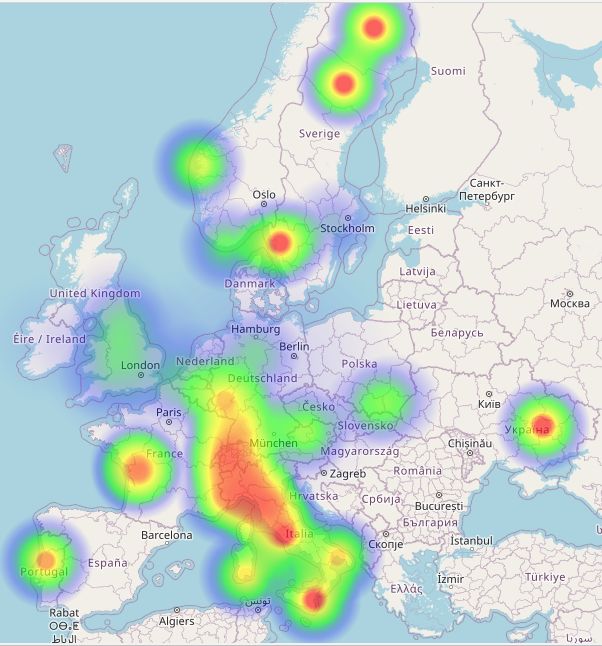
Below are heat maps for the major subclades of Z726: Z36217, Z16775, and CTS4803. Note that only Z36217 is limited to just Britain. The "wholly British" families that are so far tested or predicted as Z36217 are the Heesom/Hissem, Fletcher, Whittington/Whitenton, Clair/Clear, and Scott.
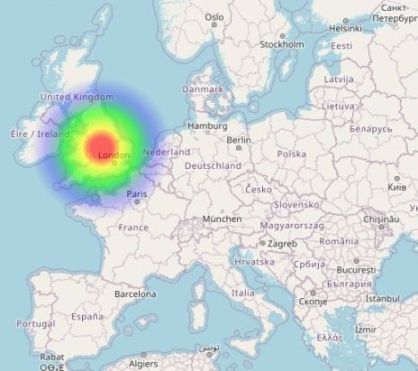
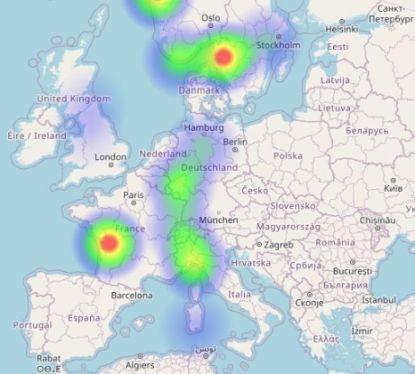
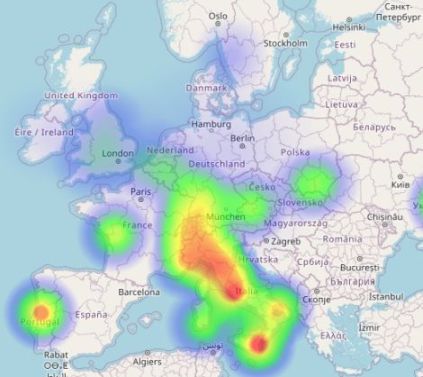
Of note, G-Z36217, which supposedly emerged in about 2,200 BC, has a branch length of 46 variants and its next subclade (there are only 2) did not emerge for over 3,300 years. To me this implies that the clade suffered a severe bottleneck, perhaps as a result of the migration to Britain. Z36217's sister clades, CTS4803 and Z16775, which remained in continental Europe, have branch lengths of only 2 and 3 variants, respectively, with multiple subclades emerging within a few centuries. I discuss branch lengths in greater detail below.
Now, I admit that no G-types have been found among the Beaker remains found in England to date, but then, no G-type has been found in Paleolithic, Neolithic or Celtic remains in Britain either. I'm just assuming that the dates work for Bell Beaker and, after all, we've been told that at this time over 90% of the British population got replaced. No such total replacement has been assumed for any later migration so the odds seem to favor this as the best time for a small number of the Z726 clade to enter the island. See below for discussions of G2a minorities amongst Beakers in Germany, Serbia and France.
The Western Bell Beaker cultures of Germany, northern France, and the Netherlands, both followed and, to some extent overlapped, with the Corded Ware culture of central Europe. The Bell Beaker culture shared a number of features with it, including pottery decorated with cord impressions, single burial, and the shaft-hole axe. Late Corded Ware drinking vessels of the Protruding Foot culture [great name, huh?] subgroup have been proposed as ancestral to the Bell Beaker drinking vessel.
The Bell Beaker culture, beginning in the Late Neolithic, circa 2,750 BC, and disappearing in the Early Bronze Age, between 2,200 and 1,800 BC, was named for the inverted bell-shaped pots they used. It spread across much of Europe, but researchers have claimed it defined more of a pottery style or trade system than a people. Today the terms Bell Beaker Complex or Bell Beaker Phenomenon are often used to differeniate it as a cultural event vice an ethnic one.
"There have been numerous proposals by archaeologists as to the origins of the Bell Beaker culture, and debates continued on for decades. Several regions of origin have been postulated, notably the Iberian peninsula, the Netherlands and Central Europe. Similarly, scholars have postulated various mechanisms of spread, including migrations of populations ("folk migrations"), smaller warrior groups, individuals (craftsmen), or a diffusion of ideas and object exchange." - from Bell-Beaker Maritime CultureOne of the things I find amusing is how in science, which is supposed to be fact-based and clear-headed, trends and fads still rule. An example is the question whether culture, like that of the Bell Beaker, is spread via the migration of peoples or the spread of ideas via cultural diffusion. The old school answer was the migration of people, but when I was a lad at university I was taught emphatically that it was through cultural diffusion, though it was never made clear what data this was based upon. Much of the distaste for migration theory apparently sprang from its mis-use in racist propaganda of the mid-century. It appears the pendulum is now swinging back.
"The 'Bell Beaker folk' have long been considered a prime example of migration in prehistory. This phenomenon is manifested by the appearance, during the third millennium BC across much of western Europe, of a combination of new pottery forms, new inhumation rites and unusual skeletal morphology (specifically brachycephalic or broad-headed skulls). In the late 1970s, at the height of the processualist reaction against migration-based explanations in archaeology, this archaeological 'culture' was newly interpreted as the diffusion of a cult package (Burgess & Shennan 1976). Yet the case for migration of Beaker using people to the British Isles remained firmly supported (e.g. Waddell 1978)." - from "Bell Beaker People in Britain: Migration, Mobility and Diet" by Pearson, et al, 2015That "firm" support for migration theory has been dramatically enhanced, at least as regards Britain, by the evidence of ancient DNA.
| The Bell Beaker Complex 2,750 BC - 1,900 BC
Archaeologically, this movement is defined by the presence of 'beaker'-shaped vessels that are generally found in funerary contexts and often next to crouched human burials. Originally considered a 'culture', in recent years the Bell Beaker phase has instead been referred to as a 'Complex' or 'Phenomenon' due to the wide range of variations seen in the design of the artefacts it produced. While the pottery always retains its distinctive 'beaker' shape, the patterns with which the vessels are decorated can differ greatly. Among these, a key group is the 'Maritime' beaker vessels, which are found predominantly in Iberia, but also along the Atlantic and Mediterranean shores. This style, defined by repeated patterns of horizontal bands over the entire surface of the pot, is thought to have originated early in the Beaker period. In central Europe, though, we are more likely to find 'All-Over-Corded' vessels, which, as the name implies, are adorned with cord-like impressions. While both types have been found in Britain, this latter style seems to have been more dominant. [Right: All-Over-Corded beaker from Bathgate in Scotland] Archery also seems to have been a defining aspect of the Complex, with paraphernalia including stone wrist-guards, flint arrowheads, and sometimes even bows found in Bell Beaker graves. Other artefacts commonly associated with such burials include copper daggers and buttons with V-shaped holes. In Britain, the most famous Bell Beaker grave is that of the Amesbury Archer from Boscombe Down in Wiltshire, but these burials have been found throughout Britain, from Orkney to Cornwall." - from "Prehistoric Pop Culture: Deciphering the DNA of the Bell Beaker Complex" in Archaeolgy.co.uk |
| Stone Wrist Guards
Why stone wrist guards? It is true that the snap-back of a bow string can impart a nasty sting to the inner part of the arm. This is true today as well, but modern archers normally use wrist guards made of leather. The Beaker people certainly knew how to tan leather so why would they use the weighty solution of stone instead? Might this stone piece have been used for another reason? It seems that the majority of wrist guards recovered have been found on the outside of the arm - from Fokkens, Achterkamp & Kuijpers, 2008. One explanation says that these stone guards, worn on the outside of the arm, may have been used to steady the arm of mounted archers. Of note, it is also claimed that the Bell Beakers were the first to bring domesticated horses to Britain. Although horses had existed in Britain in earlier times, they had become extinct at the end of the Ice Age. 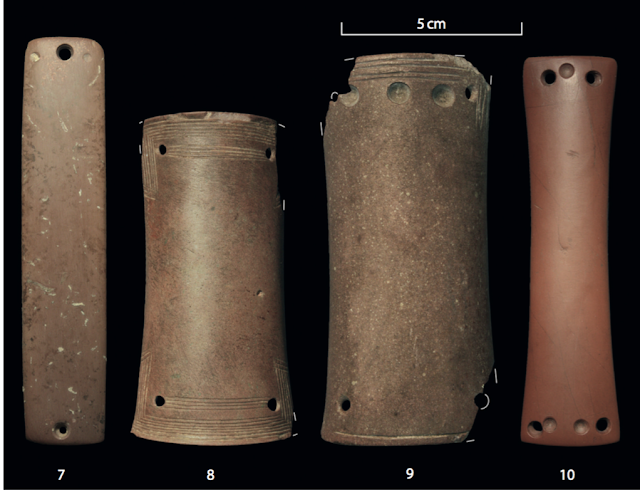 |
| The Bell Beaker Complex 2,750 BC - 1,900 BC, continued
"It is not just new material culture that seems to have spread so effectively across Europe. Presumably these artefacts were also accompanied by a set of practices, beliefs, and other intangible aspects of culture that cannot be elucidated through the archaeological record. It is this assumption that makes the Bell Beaker period so significant: the development of the Complex marks the first time archaeologically that we can see such large-scale cultural diffusion." - from "Prehistoric Pop Culture: Deciphering the DNA of the Bell Beaker Complex" in Archaeolgy.co.uk The Bell Beakers have been divided into four groups: Maritime (or Southern), Western, Eastern and Northern. Each had a particular fashion of pottery within the Bell Beaker form and numerous sub-styles within their own groups. 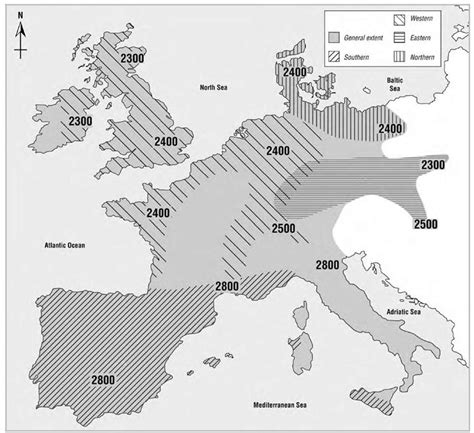 There are two prime bell beaker styles, the All Over Ornamented (AOO), patterned all over with impressions, and its subset, All Over Corded (AOC), patterned with cord-impressions, and the Maritime type, decorated with bands filled with impressions made with a comb or cord. The latter originated in Iberia. AOO and AOC evolved in the lower Rhine river and North Sea regions. However, because of extensive trade, all styles, in varying quantities, may be found across Europe. Bell Beaker Y-DNA varies by region. British BBs are, so far, 95% R1b with no G. Czech and German BBs are 93.5% R1b and 1.5% G. Dutch, French and Swiss BBs are 100% R1b. Hungarian BBs are 50% R1b, 12.5% G, and 25% I2. |
The Bell Beaker people established, or took control of, an extensive trade network in Europe. They also successfully took over many local industries. Their settlement patterns seem largely determined by nautical avenues and were non-contiguous, which makes sense since shipping, either by river or by sea, is the fastest and most efficient means of transport.
What we know about the Bell Beakers is mainly based on their grave goods. Unlike the Neolithic farmers who used common graves, the Bell Beakers buried their dead in individual graves and raised barrows over the tombs of their chiefs. Grave goods included their eponymous pots, copper daggers and axes, flint arrowheads (any wooden arrow shafts or bows interred would have disintegrated long ago), stone wrist guards, and remnants of woven goods. The Bell Beakers were apparently the first people to use woven wool fabrics held together with pins or buttons, in contrast to the previous use of leather and plant fibers.
Beaker burials contain a very specific set of grave goods. Why would perfectly good utensils and implements of real value be buried with the dead? This could be a sign of respect . . . my father-in-law was, after all, buried in his Naval uniform with his sword at his side. But the extensive grave goods of the Beakers argue for at least some belief in an afterlife in which each of these items will be required. The 'value' of these goods, then, is that they make up the necessary set, rather than any specific value they may have themselves.
It was the Bell Beakers who were the first to use alcohol in the form of honey mead and beer, which they drank from their bell-beakers; mead residue has been detected in some of these ancient pots. This new drinking culture was part of a growing pattern of warrior hospitality and feasting in an increasingly stratified society. Perhaps this was why these beakers took such a prominent place in high-status burials. In the Norse Valhalla-motif slain warriors gathered in the afterlife to feast in the god's hall of Asgard. The Beaker people may have felt that the newly buried needed their cups with them to join in the festivities to come. Below, from the Bayeaux tapestry, Norman warriors rock out at a mead-fest. I like the guy trying to drink from the wrong end of a flagon (or is that his own horn he's blowing?). Ah, looks like they're eating squirrels on a stick!
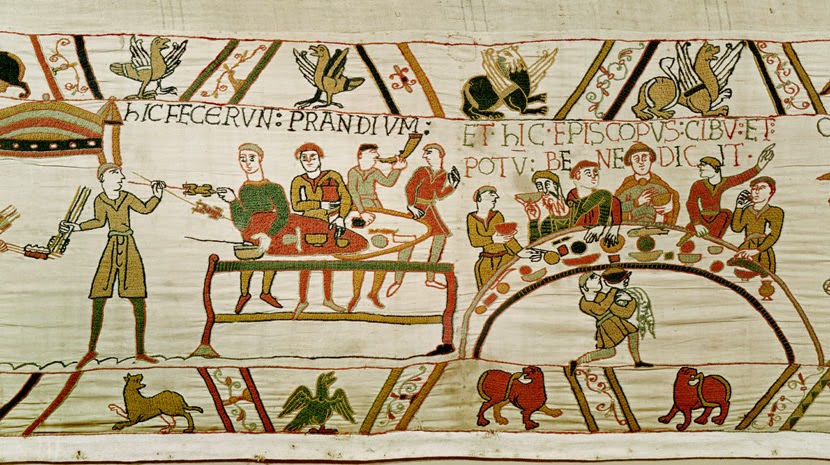
However,
"It has been suggested that the beakers were designed for the consumption of alcohol, and that the introduction of the substance to Europe may have fuelled the beakers' spread. Beer and mead content have been identified from certain examples. However, not all Beakers were drinking cups. Some were used as reduction pots to smelt copper ores, others have some organic residues associated with food, and still others were employed as funerary urns. They were used as status display amongst disparate elites." - from Bell-Beaker Maritime CultureI don't know that this kills the mead-origin theory for the beakers. After all, if you want to smelt copper or prepare food you'd be likely to grab the first vessel available, not necessarily invent a new one.
Beaker pottery is found in several different styles, but all are found across Europe implying an extensive, sophisticated trade network. Some of this was obviously by sea, the Maritime style of Iberia reaching southern Britain and Ireland.
While the Beakers introduced metalworking to many new lands, they were to a great extent still a stone age people. Their grave goods might include a copper blade and some gold trinkets, but there were also flints and stone shaping tools. The copper and gold may have served, as they do today, to denote the high status of the burial rather than implying the common use of such material.
Under the Bell Beakers the farming economy showed an increased emphasis on pastoralism (i.e. herding cattle, sheep and goats), though they also cultivated some flax and cereals, growing more barley than wheat; more beer than bread I suppose and hence the need for those beakers. This pastoralism may be a relic of their Yamnaya and Corded Wear Culture forebears or a result of a climate less suited to intensive farming.
Bell Beaker people began to arrive in Britain between 2,500 and 2,300 BC. This newly arrived culture existed alongside the Atlantic Megalithic of the native population. The Beakers appear to have absorbed aspects of the old culture, including a reverence for sites like Stonehenge.
While continental Bell Beakers were genetically diverse, ranging as they did from Iberia to the Baltic, British Bell Beakers, 95% of whom were R1b-P312, were a homogeneous and genetically distinct group. They were most closely related to individuals whose remains were recovered from a Rhenish Bell Beaker site in Oostwoud-Tuithoorn, West Frisia, the Netherlands. This suggests that, although the Bell Beaker phenomenon may have spread across Europe through the movement of ideas, in Britain its expansion occurred through the large-scale movement of people out of today's Netherlands.
| The Rhenish Bell Beakers
These people buried their dead in individual graves, often with the drinking vessel that gives their culture its name. The earliest of them still used flint; later groups, however, brought a knowledge of metallurgy and were responsible for the exploitation of gold and copper deposits in Britain and Ireland. They may also have introduced an Indo-European language to Britain.
|
Recent research shows that of the Bell Beakers who went to Britain, half had Steppe/Yamnaya ancestry and the other half were Middle/Late European Neolithic. The Olalde paper cited below also claims that the Neolithic ancestry of the British Bell Beakers is most similar to the Funnel Beaker culture peoples of northern Europe. The territory of that people had, at one time, included the Low Countries. The Salzmunde culture were a later sub-group of the Funnel Beaker living in central Germany. It was there that an analysis of variance distribution indicated the G2a-L497 subclade may have originated [though other sources suggest a variety of locations for this]. Of the remains so far tested, the Salzmunde were 50% G2a and 50% I2a, so there was a G2a population available for admixture with the Bell Beaker. I have a bit more about the Funnel Beaker and Salzmunde on a previous page, Origin of a Family: Y-DNA.
Recent tooth enamel isotope research on bodies found in Early Bronze Age graves around Stonehenge, which the Bell Beaker inhabited in that period, indicates that at least some of the new arrivals had come from Alpine regions of central Europe (this refers to the remains of the so-called Amesbury Archer). Note that the Alps of Switzerland and the Tyrol today contain some of the highest concentrations of haplogroup G2a-L497 in Europe and probably also did during this earlier time. The Alps and the Netherlands of the Rhenish Bell Beakers are connected by the Rhine river. Recent analysis indicates that the Amesbury Archer was a metalworker, which may explain why he made the journey to England and why his grave was so richly stocked.
My proposition is that the Yamnaya, and later Bell Beaker, picked up Anatolian farmer ancestry during their migrations that included our G-Z726 forebears. A proof of this proposition may be found in the Lech Valley Bell Beakers of southern Germany. A recent paper addressed Bell Beaker and Early Bronze Age burials in the Lech valley of the Tyrol.
"The article states that 17 of the samples were R1b-P312/S116*, while 10 more appeared to be R1 as well, but not derived beyond L11. Of the other Y-haplogroups identified, there were only one member of haplogroup I and two of G2 [13% of the population]. I have always maintained that haplogroups I2a2b-L38 and G2a-Z1816 [the 'grandfather' of Z726] were found among Hallstatt/La Tene Celts, so I wouldn't be surprised if a retesting of these skeletons with better quality DNA yielded these clades." - from Maciamo Hay at eupedia.comThe Lech river flows north, out of Austria, into the Danube, near the headwaters of that river. Also,
"The burials of the Lech Valley range among the richest in the entire Northern Alpine EBA [Early Bronze Age] with only a very small percentage of individuals buried without grave goods. The accumulation of economic wealth in the Lech Valley EBA communities was most probably based on the surplus production of agricultural goods due to the very fertile loess soil south of the city of Augsburg . . . HUGO_169Sk1 and UNTA58_68Sk1 [two of the identified remains], both dated to the BBC [Bell Beaker Culture], fall on the Y clade G2, which was among the most frequent in Europe in the preceding Neolithic period, and was likely carried there by the expansion of early farmers out of Anatolia." - from "Kinship-based social inequality in Bronze Age Europe" by Mittnik, et al, 2019So it would be expected that Bell Beaker types who had migrated through Central Europe, while majority R1b, would have a percentage of their folk who were G2a, perhaps as much as 10%.
Note that high-status Lech Valley remains were found buried alongside unrelated poor people of local origin; their servants, faithful retainers or slaves? Might these have been the G2 remains? Bell Beaker samples unearthed in Germany were 40% Anatolian Neolithic and 44% Yamnaya/Steppe. While these were autosomal samples the remains undoubtedly included G2a Y-DNA.
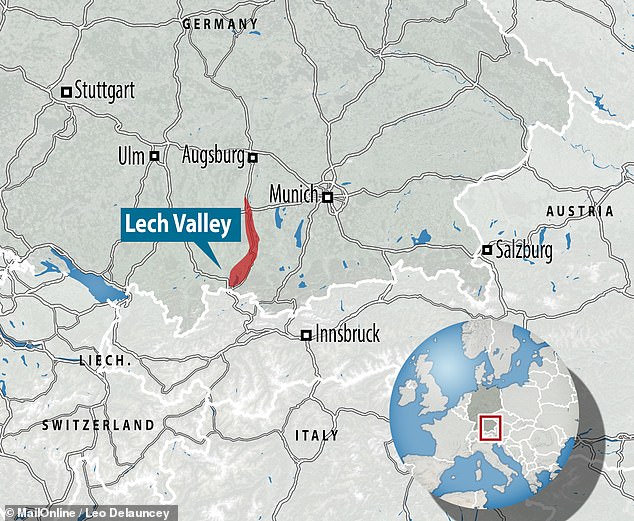
The Lech valley inhabitants were part of the Eastern Bell Beaker group; see the map below.
The following is another example of G2a remains associated with the Pitvaros/Maros, a Bell Beaker people whose site at Mokrin, Serbia is dated 2,100-1,800 BC.
"The individual Mokrin genomes [Mokrin necropolis, EBA Maros culture, Serbia, 2,100-1,800 BC] are best modelled as a mixture of Central European hunter-gatherers, Aegean Neolithic farmers and influences from the Eastern European steppes . . . Pooling individuals, admixture proportions are estimated to be around 8% (± 1.2% SE) western hunter gatherers, 55% (± 2.5% SE) Aegean Neolithic farmers, and 37% (± 2.3% SE) Eastern European steppe-like population." - from "Kinship, Acquired and Inherited Status, and Population Structure at the Early Bronze Age Mokrin Necropolis in Northern Serbia" by Zegarac et al
"Haplogroup G2 is clearly related to Southern European Final Neolithic groups, and is continued among early Bell Beakers and derived Steppe-related EBA populations: see e.g. the recent samples showing Steppe admixture among Switzerland BBC, Hungary BBC, Lech Valley BBC/EBA, or the findings of Steppe ancestry and hg. G2a in Polada EBA in the recent thesis by Graeffen 2020." - from a discussion of the paper above at Indo-European.eu
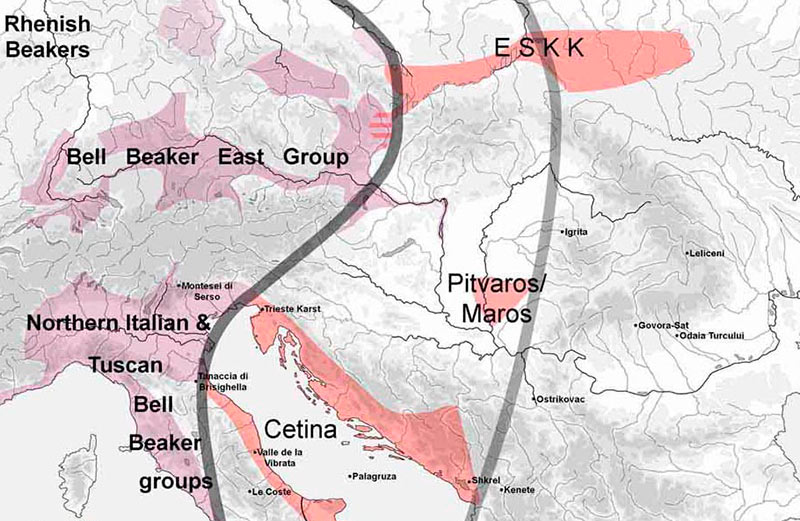
The Polada is an Early Bronze Age culture which spread primarily in the territory of modern-day Lombardy, Veneto and Trentino. They were a successor culture to the Bell Beaker and their area covered much of that of the Northern Italian & Tuscan Bell Beaker in the map above. "Population Genetic Analysis of Neolithic to BA Human Remains from Trentino-Alto Adige" called out G2a at a frequency of 9.2% for this civilization.
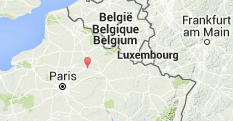 For a final example of the idea above, a recent paper, "Ancient Genomes from Present-Day France unveil 7,000 years of its Demographic History," Brunel et al, dealt with a site in Ciry-Salsogne, in northern France; see the marker on the map to the right. They analysed remains from an extended period which included Bell Beakers; the latter dated to 2,570-2,450 BC. While this is outside the Rhine valley which is at our center of interest, they were Western Beakers. The Ciry-Salsogne graves were constructed using burial practices foreign to local practice, including in their architecture and grave goods. Those seem most closely related to the practice of the Rhenish Beakers. Note that haplogroup G2a still comprised a portion of the population during the Bell Beaker era. As we'll see again with the Beaker migration to Britain, see below, the 'paternity' of this geographic region was almost completely superseded by steppe ancestry. While the sample size was low, it appears that 20% of the recovered remains (i.e., 1) were G2a in this era. This subject appears to have been G2a2b2b1a1, PF3378. This is the same as found at Boncuklu, Turkey. I got to this information via Bell Beaker Blogger, but he shows 6 male remains, 5 of which were R1b.
For a final example of the idea above, a recent paper, "Ancient Genomes from Present-Day France unveil 7,000 years of its Demographic History," Brunel et al, dealt with a site in Ciry-Salsogne, in northern France; see the marker on the map to the right. They analysed remains from an extended period which included Bell Beakers; the latter dated to 2,570-2,450 BC. While this is outside the Rhine valley which is at our center of interest, they were Western Beakers. The Ciry-Salsogne graves were constructed using burial practices foreign to local practice, including in their architecture and grave goods. Those seem most closely related to the practice of the Rhenish Beakers. Note that haplogroup G2a still comprised a portion of the population during the Bell Beaker era. As we'll see again with the Beaker migration to Britain, see below, the 'paternity' of this geographic region was almost completely superseded by steppe ancestry. While the sample size was low, it appears that 20% of the recovered remains (i.e., 1) were G2a in this era. This subject appears to have been G2a2b2b1a1, PF3378. This is the same as found at Boncuklu, Turkey. I got to this information via Bell Beaker Blogger, but he shows 6 male remains, 5 of which were R1b.
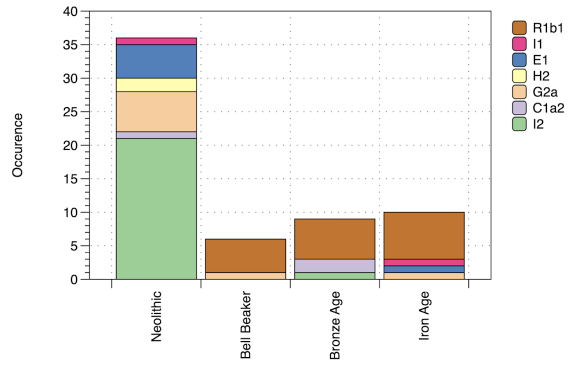
At this same time, and perhaps due to their integration into the newly dominant culture(s), the G2a haplogroup began a rebound.
". . . during the first half of the third millennium BC, yfull estimates that L497 underwent a massive expansion and development, with 12 new branches forming in 2,600 BC alone [including Z726]. All of these branches look West European and are estimated to have arisen during the Bell Beaker expansion period, long before the Urnfield culture and the Celts came into existence." - from eupedia.comSo, as conjectured at the top of this page, our G2a forebears who survived the R1a/R1b onslaught had come out of 'hiding' by the middle of the third millenium and joined the expansion of the Corded Wear and Bell Beaker cultures.
The Bell Beaker migration to Britain resulted in a major ethnic shift in the British population.
"British Neolithic farmers were genetically similar to contemporary populations in continental Europe and in particular to Neolithic Iberians [Cardial Pottery Culture], suggesting that a portion of the farmer ancestry in Britain came from the Mediterranean rather than the Danubian route of farming expansion [i.e. not our family's route]. Beginning with the Beaker period, and continuing through the Bronze Age, all British individuals harboured high proportions of Steppe ancestry and were genetically closely related to Beaker-associated individuals from the Lower Rhine area. We use these observations to show that the spread of the Beaker Complex to Britain was mediated by migration from the continent that replaced >90% of Britain's Neolithic gene pool within a few hundred years, continuing the process that brought Steppe ancestry into central and northern Europe 400 years earlier."The Bell Beaker 'invaders' had genetic markers for lighter skin and eyes than the Neolithic population they supplanted. However, they did not have the gene that provided the capability to digest lactose. See also,
"In either case, our results imply a minimum of 90 +/- 2% local population turnover by the Middle Bronze Age (approximately 1,500-1,000 BC) . . . our results imply that for individuals from Britain during and after the [Bell] Beaker period, a very high fraction of their DNA derives from ancestors who lived in continental Europe before 2,450 BC. An independent line of evidence for population turnover comes from uniparental markers. Whereas Y-chromosome haplogroup R1b was completely absent in Neolithic individuals (n = 33), it represents more than 90% of the Y chromosomes in individuals from Copper and Bronze Age Britain (n = 52) (Fig. 3). The introduction of new mtDNA haplogroups, such as I, R1a and U4, which were present in Beaker complex-associated populations from continental Europe but not in Neolithic Britain (Supplementary Table 3), suggests that both men and women were involved in this population turnover." - from "The Beaker Phenomenon and the Genomic Transformation of Northwest Europe" by Olalde et al
"Recent archaeogenetic evidence has shown that the spread of the BBC [Bell Beaker Culture] throughout continental Europe did not involve large-scale migrations; only the British Isles witnessed a massive immigration of individuals from the continent during this time - leading to the almost complete extinction of previous Neolithic genetic signatures." - from "Kinship-based social inequality in Bronze Age Europe" by Mittnik, et al, 2019Note too,
". . . both the 'All-Over-Cord' and 'Maritime' Beaker designs are known in Britain, suggesting cultural influences from both central Europe and Iberia. It would seem logical that these two separate, although linked, styles would have been introduced to the region by different groups - but the new genetic results seem to indicate that this was not the case. Rather, regardless of pottery style, all the sites studied suggest a shared origin with central European Beaker populations, with no evidence for the migration of Iberian Beaker people into Britain at all. - from "Prehistoric Pop Culture: Deciphering the DNA of the Bell Beaker Complex" in Archaeolgy.co.uk
| The Bell Beaker in Britain
The Beakers absorbed portions of British Megalithic culture, perhaps very much of it. This included religion; Beakers completed Stonehenge as we see it today, erecting a 100 foot diameter circle of 30 sarsen-stone (weighing up to 50 tons each) uprights capped by a continuous ring of sarsen lintels in the center of the site. No other megalithic structure in northwestern Europe displays the precision and architectural refinement that Stonehenge does. "They [the Bell Beakers] improved the existing temple at Stonehenge, which is proof that they got on well with the original inhabitants, and at Avebury they made another great henge monument. This is a large circular ditch and bank, and within it was a ring of standing stones - although these have now gone. Nearby, at Silbury Hill, stands the largest man-made mound in prehistoric Britain, again thought to have been made by the Beaker people. No burial has been found inside it." - from "Bronze Age Britain" at the BBCMany high-status burials of the Beakers were placed in the vicinity of Stonehenge, including those of the Amesbury Archer and the Boscombe Bowmen. "[T]he Amesbury Archer and some of the Boscombe Bowmen were migrants." - from "The Amesbury Archer and the Boscombe Bowmen: Early Bell Beaker Burials . . ." by A.P. Fitzpatrick. Bell Beaker sites have been identified throughout southern England and Wales, in east Yorkshire and the Peak District, and in eastern Scotland. The map to the right displays Beaker-period burials in Britain for which isotopic analysis has been undertaken. The Bell Beaker in Yorkshire
Of particular interest are the Ferriby boats, three Bronze Age vessels, built of sewn-planks circa 2,000-1,700 BC, that were discovered on the north shore of the Humber estuary. A sewn boat is a type of wooden boat which is clinker built and planks sewn, stitched, tied, or bound together with tendons or flexible wood, such as roots and willow branches. At about 6 feet wide and 43 feet long they may have been used for cross-channel travel (by the brave at least). The discovery of fragments of another ancient sewn-plank boat were found at Kilnsea, at the far seaward end of the estuary. Its size could not be determined, but it is older than the Ferriby boats. The Kilnsea site would have been ideally suited as a landing place for craft crossing the North Sea. There is also archaeological evidence for farming on the Humber shore and beyond, a nearby Bronze Age settlement, several monuments, including two Bronze Age barrows, a possible mini-henge, and the remains of a Neolithic house. - abstracted from "An Ancient Seascape: The Social Context of Seafaring in the Early Bronze Age" by Van de Noort. 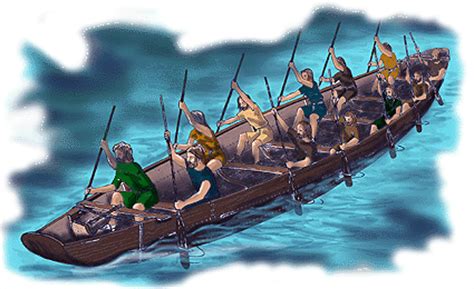 |
The movement into Britain was not a trickle of migration, but a succession of great waves that resulted in a large population turnover in Britain.
"This central European population movement into Britain was swift and hugely successful, DNA analysis suggests. After 2450 BC, when the Beaker Complex first arrived in the region, all sampled individuals from Britain show an abrupt change in their genome, with central European Bell Beaker-associated lineages suddenly accounting for the vast proportion of their overall ancestry. Over the next few hundred years, the proportion of this migrant DNA continued to vary slightly, indicating that some mixture with local Britons was ongoing – although it still accounted, on average, for at least 90% of ancestry. But by the end of the Beaker period the population had completely homogenised, and it seems that the Neolithic peoples of Britain – the ones who built Stonehenge, traversed the Sweet Track, and settled Skara Brae – had all but disappeared." - from "Prehistoric Pop Culture: Deciphering the DNA of the Bell Beaker Complex" at Archaeology.co.ukThe diagram, below, from a Nature magazine article about the study, dramatically illustrates this change. The left side of the chart shows autosomal DNA, that is the entire ancestry of the individual, while the right side shows just the Y-DNA bit. As you'll see, the Neolithic population of Britain had been I2a. If there was any G2a in Britain during the Neolithic, it would have been G-M406 that had come via the southern route, through Iberia.
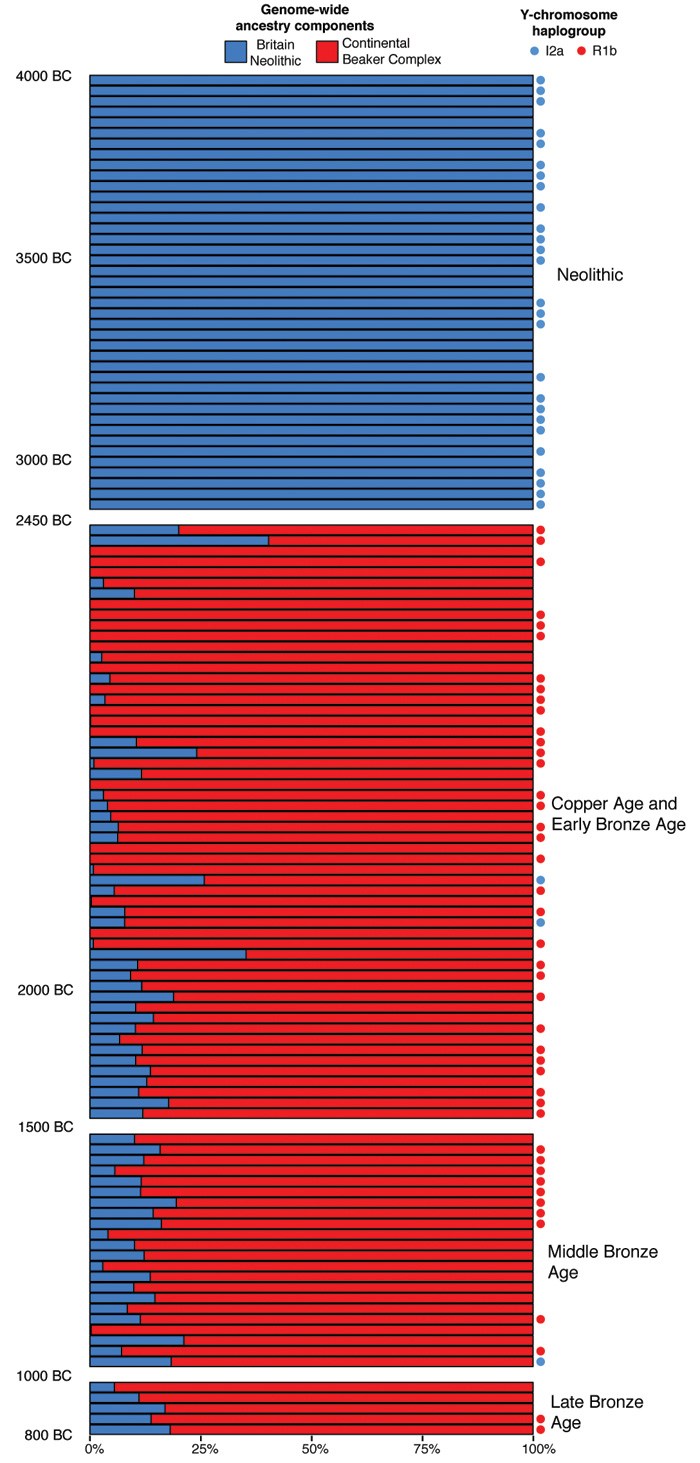
How could such a massive population replacement have happened? "Did the incoming Beaker people have better technologies, social organization, or ways of feeding themselves? Or were the early British farmers they mostly replaced already on the slippery slope to population collapse?" Again, violence and disease may have played a role.
What did this invasion look like? It was probably the case of small groups entering Britain, most likely as traders. They would have lived at the sufferance of the native population, valued for the goods they brought for sale. After a time these solitary traders would be joined by their families and kinsmen. Available land would have been taken peacefully, at first, and then, as the new people grew in number and felt their strength, they could have taken what they wanted. While their weapons were really not a great improvement on what the native populace possessed, they were a vigorous, growing population and the Neolithic people of Britain were already in a decline. As Hemingway wrote, and which applies to cultural collapse as well,
"How did you go bankrupt?" Bill asked.For a long time the native Britains would have been unaware of their danger.
"Two ways," Mike said. "Gradually and then suddenly."
However, and unfortunately for my theory, I am not aware of any ancient G2a remains that have been found in Britain. Remember that even today, haplogroup G makes up just 2% of the English population. The initial Bronze Age population would have been as small. Also note that those bodies found to date have been from high-status graves and I'm assuming my G2a forebears were at best peasants, and at worst slaves.
The map below, from Scaled Innovation, shows a possible path for haplogroup G2a to get to Britain, in this case down the Rhine, through the Rhenish Bell Beakers' homeland, evolving to G-Z726 circa 2,600 BC, and finally into Britain, where it evolved into our G-Z36217 circa 2,000 BC. Inconsistencies with the path I've discussed above have much to do with this pathway being "smoothed" to remove the zig-zags and retrograde movements of human migration.
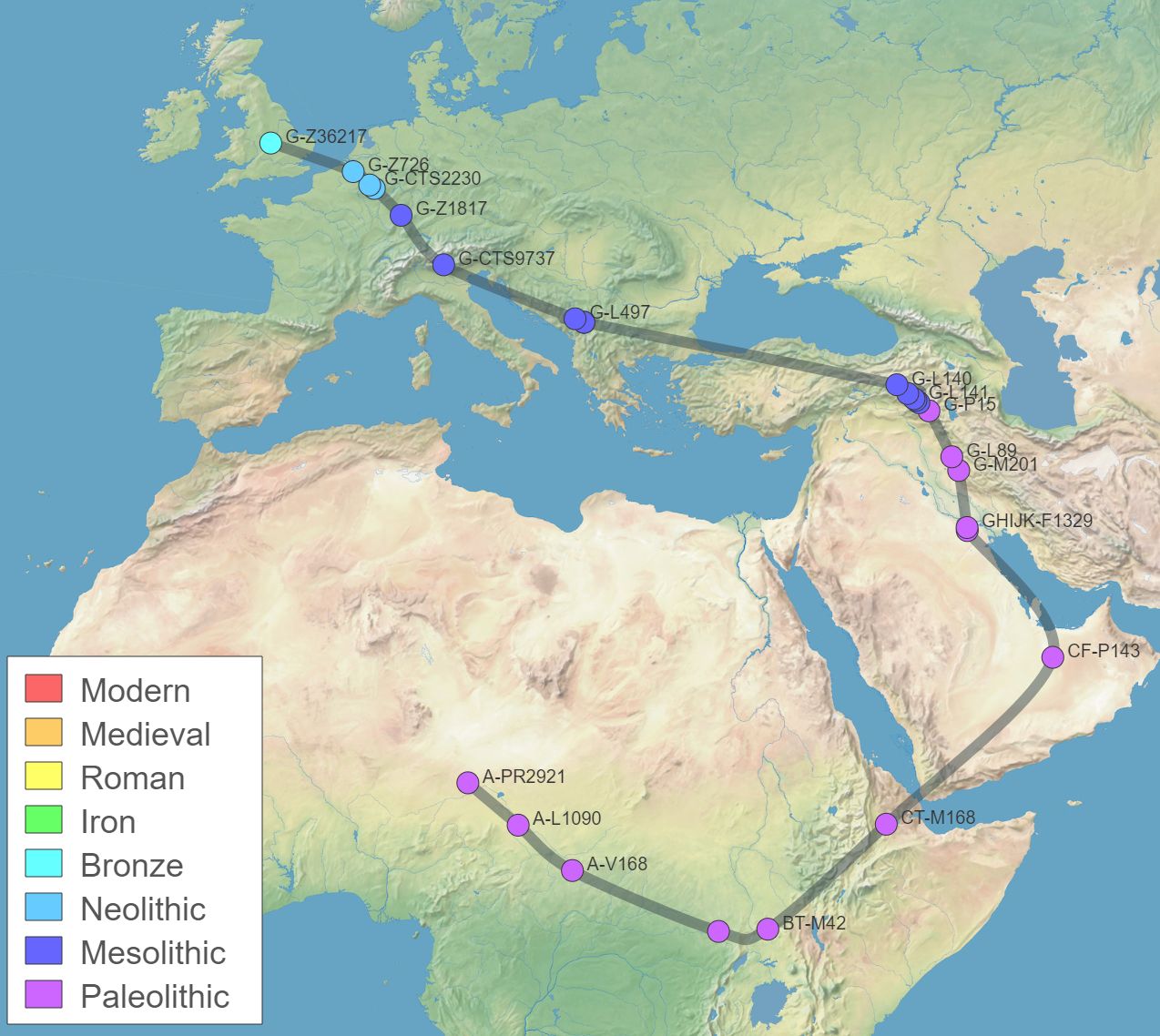
British Beaker burials have been divided into three chronological stages.
"The earliest period (c. 2450/2400-2300 cal BC) is characterised by Low-Carinated [a beaker form] Bell Beakers, while non-perishable grave goods include copper knives, stone wristguards, barbed-and-tanged flint arrowheads, flint tools and flakes, boars' tusks, bone pins, antler or bone spatulae, belt rings, iron pyrites strike-a-lights, gold hair-tress rings and other ornaments, such as those accompanying the Amesbury Archer.Fission refers to the regionalization of beaker styles,
The second period begins around 2300/2250 cal BC with a 'fission horizon', when a wide range of pot styles was adopted for funerary use. From this point onwards, these British pots are known simply as 'Beakers' to distinguish them from the earlier, pan-European style of Bell Beaker. Copper was succeeded around 2200/2150 BC by bronze.
Needham's third period (c. 1950-1810 cal BC) equates with Wessex I [see below], the horizon of gold-provisioned burials (both inhumations and cremations) of Britain's Early Bronze Age." - from "Beaker People in Britain: Migration, Mobility and Diet" by Pearson, et al, 2016
". . . that there was one critical point of rapid mutation in both pot form and associated artefacts. This phase is referred to as a fission horizon . . ."The phase previous to the 'fission horizon' had been a 'fusion' of a few styles across a wide range.
"In reviewing the continental background for Beaker-carrying cultures, a corridor of Bell Beaker/Corded Ware fusion is perceived along the southern flanks of the Channel. This created a modified spectrum of Beaker culture which stands at the head of the insular [i.e. island] phenomenon."By 1,900 BC the Bell Beaker phase had passed.
Of course, whether our family was part of some continental Neolithic culture or the member of a Bronze Age Beaker clan, they were still peasants, using a stone-tipped plow (bronze and iron were luxury items) and pulling a forelock to the bosses, whoever they were.
| Early British Geography
Most of Bell Beaker sites discovered in East Yorkshire are north, in the drier lands of the Wolds. Below is a map of the region in 1066, when King Harold fought the Danes at Stamford Bridge (S). The Wolds are the highlands to the east of Stamford Bridge. 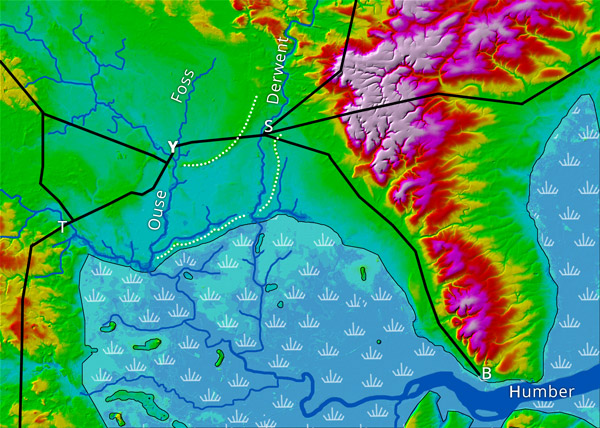 Y=York, T=Tadcaster, B=Brough Below is another view of the wetlands of northern Britain. 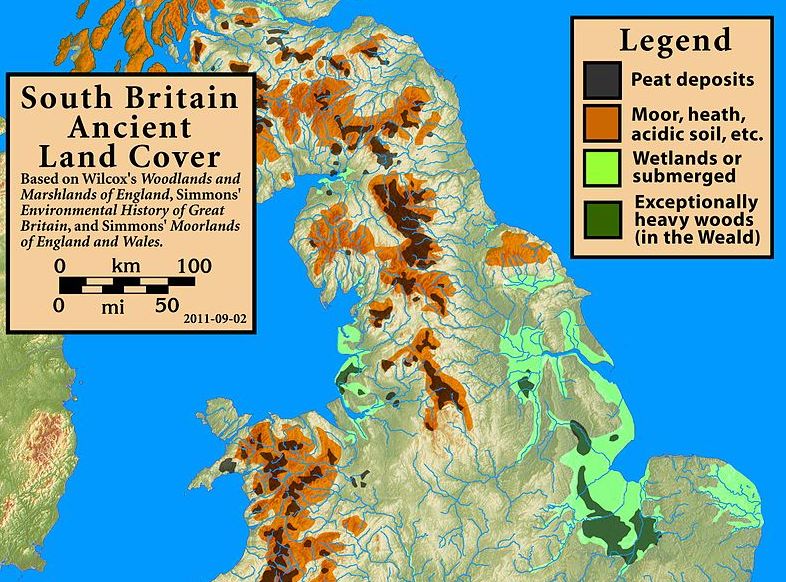 |
While the people of Britain were now predominantly the descendants of the Bell Beaker people, new methods of pottery making and metal working evolved over time which modern scholars have identified as new cultures.
The Wessex culture was the predominant prehistoric culture mainly concentrated on central and southern Britain of the early Bronze Age, and it can be seen today as a sub-category of the Beaker culture. It is not related to the Saxon kingdom of Wessex nor was the culture geographically limited to Wessex.
"The emergence of the Beaker people in Britain gave rise to what is now termed the Wessex Culture. This is the name given to a number of very rich grave goods under round barrows in southern Britain. The grave goods include well made stone battle axes, metal daggers with elaborately decorated hilts, and precious ornaments of gold and amber - these are some of the loveliest prehistoric objects ever to be found in Britain. Among the golden cups found in the graves, some were found that were so like those of the Mycenae that they are used as examples to prove the existence of trade between Wessex and Greece." - from "Bronze Age Britain" at the BBC
The culture is related to the Hilversum culture of the southern Netherlands, Belgium and northern France, and linked to the Armorican Tumulus culture of Brittany. These were developed out of the Middle Rhine group of Beaker culture. The period saw fresh arrivals of Beaker Folk from these regions.
The Wessex culture is commonly subdivided in the consecutive phases: Wessex I, 2,000-1,650 BC, and Wessex II, 1,650-1,400. Wessex I is a transional phase from the Bell Beaker and is closely associated with the construction and use of the later phases of Stonehenge, which did not complete until circa 1,600 BC.
They buried their dead under barrows using inhumation, but later using cremation and often with rich grave goods. They appear to have had wide ranging trade links with continental Europe, importing amber from the Baltic, jewellery from modern day Germany, gold from Brittany as well as daggers and beads from Mycenaean Greece [see above for a contrary view] and vice versa. It has been speculated that river transport allowed Wessex to be the main link to the Severn estuary. The wealth from such trade probably permitted the Wessex people to construct the second and third (megalithic) phases of Stonehenge and also indicates a powerful form of social organisation.
When the term 'Wessex Culture' was first coined, investigations into British prehistory were in their infancy and the unusually rich and well documented burials in the Wessex area loomed large in literature on the Bronze Age. During the twentieth century many more Bronze Age burials were uncovered and opinions about the nature of the early-mid Bronze Age shifted considerably. Since the late 20th century it has become customary to consider 'Wessex Culture' as a limited social stratum rather than a distinct cultural grouping, specifically referring to the hundred or so particularly richly furnished graves in and around Wiltshire. The culture group, however, is named as one of the intrusive Beaker groups that appear in Ireland - from Wikipedia.
The weather, previously warm and dry, became much wetter as the Bronze Age continued, forcing the population away from easily defended sites in the hills and into the fertile valleys. Large livestock farms developed in the lowlands which appear to have contributed to economic growth and inspired increasing forest clearances.
It was in the period between the end of the Wessex period and the beginning of the Deverel-Rimbury culture that the volcano of Thera, on what is now the Greek island of Santorini in the Aegean Sea, erupted with the force of two million Hiroshima bombs in 1,600 BC. The eruption sent 24 cubic miles of rock into the atmosphere, four times more than the 1883 Krakatoa eruption. It blocked out the sun and threw the world into a period of bitter cold. Famines spread in Egypt as crops failed, and evidence of the eruption can even be found in the earliest Chinese written chronicles.
"At the time of King Chieh the sun was dimmed," the records say. "Three suns appeared . . . Winter and summer came irregularly . . . Frosts in July."
The Deverel-Rimbury culture of the middle Bronze Age, 1,600-1,100 BC, followed the Wessex culture and featured a "devolved" Hilversum type pottery. The culture is characterized by globular, barrel-shaped, and bucket-shaped ceramic urns, extensive field systems, and settlements with round houses. Burials are usually cremations placed in urns or in simple pits dug into the ground, and typically cluster around earlier round barrows (so much for ancient DNA).
"The standard farming household consisted of two houses, a main living house and an out-house for cooking and textile production. The dead were cremated, and buried in small cemeteries behind each settlement. The large burial sites of the early Bronze Age were a thing of the past, as the land was now needed for agriculture.During the Bronze Age the forests of the Paleolithic were cut down with bronze axes and the land was parceled up and converted into mass farming systems. The population exploded. Elite groups emerged and ruled over more complex societies.
The late Bronze Age was also signatured by advanced pottery-making techniques, and more sophisticated weapon-making. The Iron Age that followed it did not happen suddenly, but is thought to have started in Britain around 650 BC and finished around AD 43. Again, the knowledge of iron-making was brought to Britain by Europeans, who had already started to build the first blast furnaces." - from "Bronze Age Britain" at the BBC
The first subclades of G2a-Z36217, FT115823 and BY77286, emerged around 1,200 BC, at the end of the population explosion.
The Hekla volcano, in Iceland, erupted in about 1,100 BC in its most cataclysmic eruption, an event known as Hekla 3. It threw nearly two cubic miles of volcanic rock into the atmosphere, and kicked off an eighteen-year span of cooling that can be detected in Irish bog oaks and Greenland ice cores. The rapid climate change that descended over northern Europe seems to have driven a vast number of refugees southward, placing unsustainable stresses on the region. Far to the southeast, famine, rebellions and outside attacks caused the Mediteranean societies of the Bronze Age to collapse like dominos in a period known as "The Late Bronze Age Collapse."
The climate in Britain became significantly wetter. There followed a period of cultural decline as agriculture became more difficult and the population shifted into the fertile river valleys from the uplands and lowlands.
It was also at this time that archaeologists conjecture that an influx of proto-Celts from the continent entered the island causing further disruption, upending again the social hierarchy.
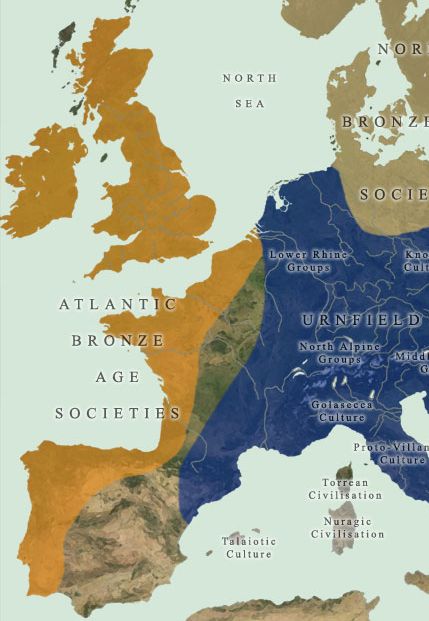 Atlantic Bronze Age Societies 1,300 BC - 700 BC
Atlantic Bronze Age Societies 1,300 BC - 700 BC
A group of cultures, outside the Urnfield of the late Bronze Age, 1,300-700 BC, along the Atlantic shore of Western Europe. It was marked by economic and cultural exchange that led to the high degree of cultural similarity exhibited by communities from Portugal to Galicia, Armorica and Scotland. The period was defined by a number of distinct regional centres of metal production, unified by a regular maritime exchange of some of their products. The major centres were southern England and Ireland, north-western France, and western Iberia.
British communities developed close contacts with their continental European neighbours. Some of the earliest hill forts in Britain were constructed in this period. Though formally belonging to the late Bronze Age, they usher in the succeeding Iron Age cultures.
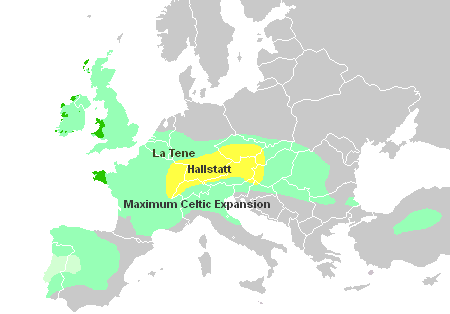 The Celtic culture first appeared in the Late Bronze Age in the area of the upper Danube sometime around the 13th century BC.
The Celts were not a homogenous ethnic group, though they spoke a generally similar language and shared an artistic tradition. This was not a new wave of immigrants or invaders. Rather, this was a new culture arising amidst the steppe-ancestry people of Europe out of the previous Tumulus and Urnfield cultures.
The Celtic culture first appeared in the Late Bronze Age in the area of the upper Danube sometime around the 13th century BC.
The Celts were not a homogenous ethnic group, though they spoke a generally similar language and shared an artistic tradition. This was not a new wave of immigrants or invaders. Rather, this was a new culture arising amidst the steppe-ancestry people of Europe out of the previous Tumulus and Urnfield cultures.
The first recorded use of the name of Celts to refer to an ethnic group was by Hecataeus of Miletus, the Greek geographer, in 517 BC, when writing about a people living near Massilia (modern Marseille). In the fifth century BC, Herodotus referred to Keltoi living around the head of the Danube (that is, Switzerland, the Tyrol and southwestern Germany) and also in the far west of Europe. - from Wikipedia. The Romans generally referred to the Celts as Gallia (Gauls), that is, barbarians.
The Urnfield culture of central Europe, 1,200-700 BC, a precursor to the Hallstatt, probably represents the beginnings of the proto-Celtic and was associated with a dramatic increase in population in the region.
The Hallstatt culture 800-500 BC was named for the rich grave finds found in Hallstatt, Austria and earned the area the perhaps unearned name of "Celtic Homeland." Celtic river-names are found in great numbers around the upper reaches of the Danube and Rhine which lead many Celtic scholars to place the ethnogenesis of the Celts in that area. The expansion of the Hallstatt was powered by the discovery of iron-working.
The Alpine Celts of the Hallstatt culture have been associated with the U152/S28 mutation of haplogroup R1b-L51 and, interestingly, that sub-clade had its probable origin in southern Germany, near the origin of the Hallstatt Celts around the upper reaches of the Danube and Rhine. Below is a representation of modern day population densities for G2a-L497 and the Celtic-centric R1b-U152. It has been claimed that these show evidence of a mixing of the two groups and a subsequent joint migration pattern into the Alps, the Po river valley and Tuscany.
"G2a-L497 (or actually its Z1816 subclade) was probably assimilated by the R1b-U152 Proto-Italo-Celts before moving to the Alps. Not only is there a strong geographic correlation with the Le Tene culture, L497 also matches the distribution of Italic tribes in Italy." - from eupedia.comNote that ancient Y-DNA from remains dated to this period were found at the proto-Celtic Hallstatt site in Mitterkirchen, Upper Austria. One sample tested as G2a2b2a[1a]1b (L497) - from eupedia.com. So, as hinted at above, the Neolithic G2a population, while suffering a decrease in overall numbers due to the R1b invasion, was eventually absorbed by what became, over time, the Celtic culture.
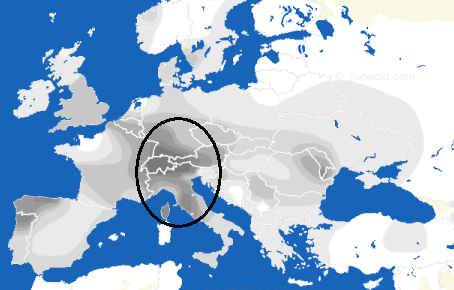
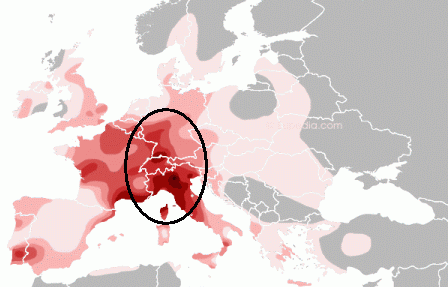
The Hallstatt culture had declined by the 5th century BC. While it had been centered along the upper Danube in Austria, the locus of the subsequent Le Tene shifted west to the upper Rhine and Rhone rivers of Switzerland and eastern France. Hallstatt was also a predecessor to the Villanovan Culture of northern Italy that you'll read about on the next page. Their successors were the Etruscans.
| The Iron Age
This era introduced the production of carbon steel tools and weapons. These were vastly superior to their bronze antecedents. This initially took place in the Middle East in the aftermath of the Bronze Age collapse in the 12th century. This archaelogical age is generally thought to end with the beginning of the historical period, circa 550 BC. |
The term "Le Tene" refers to a late Iron Age Celtic culture, roughly centred in Switzerland. During this period, from 450 BC to the Roman Conquest, the Celtic culture spread to Belgium, eastern France, Austria, Southern Germany, the Czech Republic, Poland, and beyond.
Le Tene culture developed out of the early Iron Age Hallstatt culture without any definite cultural break, under the impetus of considerable Mediterranean influence from the Greeks at their colony at Massalia (modern-day Marseilles) in pre-Roman Gaul, and from the Etruscans, especially after they moved into the Po river valley abutting the Celtic Alpine tribes. There were three zones of power and innovation for the Le Tene: Marne-Champagne and Moselle-Rhineland zones in the west with trading links to the Po Valley via the central Alpine passes and a Bohemian zone in the east with separate links to the Adriatic via the eastern Alpine routes and the Venetic culture.
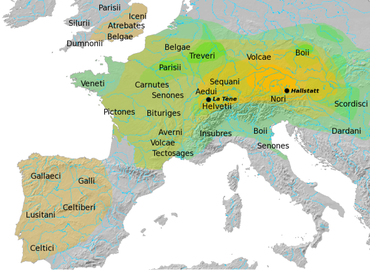 Le Tene cultural material appeared over a large area, including parts of Ireland and Great Britain.
Le Tene cultural material appeared over a large area, including parts of Ireland and Great Britain.
The culture achieved its zenith during the expansion of Celtic power and influence during the fourth century BC. An expanding population around 400 BC and migration south and west led to instability and war. In about 387 the Celts defeated the Romans and then sacked Rome, making themselves the most prominent threat to Rome in that period. The Roman-Gallic wars ended with Julius Caesar's final conquest of Gaul in 58-50 BC. Its decline and defeat was simply reflective of the political weakness of the Celts themselves: despite their strong hold over European trade, especially along the principal European waterways like the Danube, the Rhine and the Rhone, and the ferocity of their warriors in battle, their loose network of tribal societies lacked the internal cohesion and central authority to compete with the unified Roman state.
It is not known when the Celts migrated into Britain, but it began before the Roman conquest and accelerated as a result of the conquest of Gaul. Julius Caesar noted that members of some defeated Gaulish tribes were fleeing into Britain, circa 50 BC.
The expansion of the Le Tene culture from Switzerland is associated with the diffusion of the Z36 branch of R1b-U152, which would generate the Belgae around modern Belgium and in the Rhineland, the Gauls in France, and the Cisalpine Celts in Italy.
While the Celtics initially expanded to cover most of Europe they were later squeezed out of central Europe by the influx of Germanic tribes. The last independent Celtic areas were Gaul, Noricum, Raetia, and Northwestern Pannonia in Central Europe, Galicia, Asturia and Cantabria in the Iberian peninsula, and the British islands.
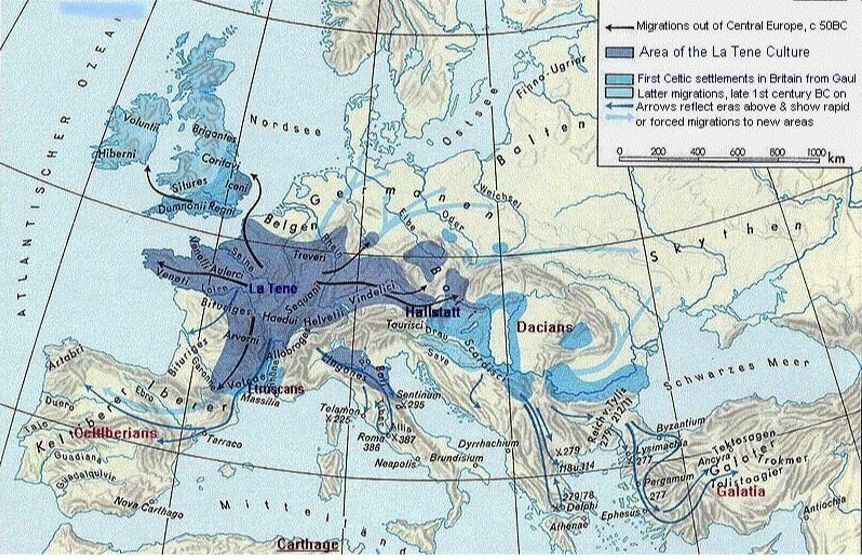
The majority of people we define as Celts in Britain were the descendants of the people already living there at the start of the Bronze Age; that is, they were the remnants of hunter-gatherer migrants from Paleolithic refugia, Neolithic farmers that had come up from Iberia, and the surge of Bell Beaker folk out of the Rhineland (and their followers).
"The traditional view that the Celtic Britons originally migrated from mainland Europe, predominantly across the English Channel — with their languages, culture and genes in the Iron Age (8th century BC to 1st century AD) — has been questioned . . . the results of genetic studies show a large continuity between Iron Age and older British populations . . . Genetic studies on the limited amount of material available suggest continuity between Iron Age people from areas considered Celtic and the earlier Bell Beaker culture of Bronze Age Western Europe" - from WikipediaThe indigenous people of Britain became Celts over time by absorbing the dominant Iron Age culture of northwestern Europe. Later, some continental Celts would migrant to Britain, pushed west by Germanic tribes coming south and west out of Scandanavia and a Roman Empire expanding northwest out of the Mediterranean.
There is evidence of Celtic Hallstatt-era material culture along the shore of Britain from Hampshire to Lincolnshire, though no evidence of migration into the island. The earliest ironsmiths made daggers of the Hallstatt type but of a distinctively British form. The characteristic Celtic pottery and burial artifacts found in England only date to about 500 BC, but it is likely that the Celtic language and culture covered Britain and Ireland long before that, if only due to cultural diffusion from the continent.
". . . from [the] Iron Age the EEF [Early European Farmer] component increased again in UK, maybe in association to [sic] the arrival of Celtic speaking groups from Central Europe (possibly carrying lineages such [as] R-U152, I2, G-L497 . . .)." - from the eupedia.com forum
The 6th century BC saw the building of many large hill forts throughout the island. This suggests the emergence of powerful chieftains and the growth of strife as an increasing population created pressures on the land. By 300 BC swords were making their appearance once more in place of daggers. Finally, beginning in the 3rd century, a British form of La Tene Celtic art was developed to decorate warlike equipment such as scabbards, shields, and helmets, and eventually also bronze mirrors and even domestic pottery. During the 2nd century the export of Cornish tin, noted before 300 BC by Pytheas of Massalia, a Greek explorer, continued. The evidence of its destination is provided by the Paul hoard of north Italian silver coins in Cornwall. In the 1st century BC this trade was in the hands of the Veneti of Brittany. Their conquest by Julius Caesar in 56 BC seems to have put an end to it. - adapted from Britannica.com
In addition to the cultural diffusion of the Celtic culture into the island there was also a migration, or invasion, from the continent dating from as early as the end of the 2nd century BC.
"The interior parts of Britain are inhabited by tribes which by their own traditions are indigenous to the island, while on the coastal sections are tribes which crossed over from the land of the Belgae seeking booty. Nearly all these maritime tribes are called by the names of the lands from which they immigrated when they came to Britain. After their arrival, they remained there and began to till the fields" - from De Bello Gallico by Julius CaesarThe tribes involved included the Belgae, Atrebates, Catuvellauni and Regnenses. There was also, not surprisingly, an increase in warfare and social strife at about this time that is well attested in the archaeological record.
The population of Britain was perhaps 3 to 4 million at the beginning of the 1st century BC, with most of them concentrated in the agriculturally rich lands of the south.
The Belgae and Atrebates in Southeastern BritainJulius Caesar was told that the Belgae, a Le Tene culture tribe from northern Gaul, had settled along the coast of Britain, many retaining the same tribal names as their brethren across the Channel. Caesar asserts they had first crossed the channel as raiders, only later establishing themselves on the island. This is compatible with the archaeological evidence. From 125 BC Gallo-Belgic coins appear over the whole of south-eastern Britain. New tribal centres appeared, similar to those in Gaul. Known as oppida, these were large, fortified, lowland settlements. Among their inhabitants were craftsmen making the first British wheel-thrown pottery and minting the first British coins. They seem to have spoken a language similar to Gaulish, but even more similar to Brythonic, the proto-Celtic language of old Britain.
It seems that the Belgae had pushed into North-East Gaul from what had been Celtic-speaking lands east of the Rhine, under pressure from the expanding Germani. The pressure of the Germani may also explain the arrival of Belgae in Britain. They in turn may have pushed previous inhabitants further north.
The Parisi in Yorkshire 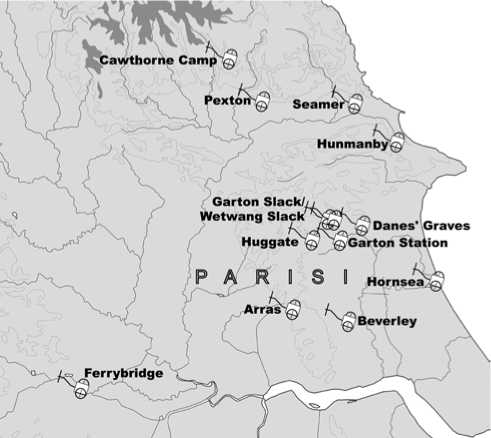 The Iron-Age Parisi people of pre-Roman Britain, a Celtic tribe, lived in what today is East Yorkshire. They were identified by the Romans as members of the Brigante confederation of tribes which dominated northern Britain. Today they are loosely associated with the Arras culture first identified at the Arras farm in Yorkshire in the 19th century. To the left is a map of excavated cart and chariot burials of the Arras culture.
The Iron-Age Parisi people of pre-Roman Britain, a Celtic tribe, lived in what today is East Yorkshire. They were identified by the Romans as members of the Brigante confederation of tribes which dominated northern Britain. Today they are loosely associated with the Arras culture first identified at the Arras farm in Yorkshire in the 19th century. To the left is a map of excavated cart and chariot burials of the Arras culture.
The people of the Arras culture first appeared in Yorkshire near the Humber river in the 5th century BC. They may have been part of the Celtic Belgae peoples who originated in the Marne region of northern France. This was one of the three primary clusters of the La Tene culture. The Arras' material culture, especially its chariot and cart burials, is very similar to the La Tene of the continent. 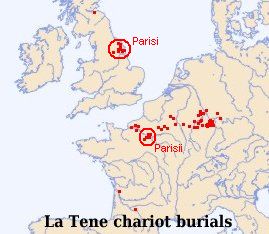
"The rite of elite burial distinguished by two-wheeled vehicles, which developed in the Marne and Moselle regions in the late fifth century, was adopted in four peripheral areas: in the lower Seine Valley, the Ardennes, the Haine, and Yorkshire." - from Cunliffe 1997Chariot burials are "only found elsewhere [than in the Arras culture] in the Seine (e.g., Parisii and Senones), Marne (e.g., Remi and Catulvellauni) and Moselle (Treveri) regions." - from "The La Tene Celtic Belgae Tribes in England" by David K. Faux.
"A second outlier is from Ferrybridge in West Yorkshire where the individual was buried on top of the vehicle, with the wheels still attached and hence upright, more in keeping with Continental traditions." - from FauxFerrybridge is just north of Pontefract, not far from the homes of our 16th century ancestors. A chariot burial has also been discovered on the lands of the Votadini tribe, in Scotland.
The Parisi may be related to the Parisii tribe of Gaul, who resided in and around today's city of Paris. While it is not certain that these two tribes were connected, despite the similarity in their names, there is archaeological evidence to support a Celtic migration into Yorkshire circa 500-400 BC. More migrated in the wake of the conquest of Gaul and Belgica by Julius Caesar in 50 BC.
The Parisii of France would have been predominantly haplogroup R1b-U152, though, as noted above, would have minorities of other types, including G2a-Z726.
"Gallo-Belgic coins are also found in many coastal areas of Britain, introducing the triple-tailed horse design on the reverse that becomes widespread over the next few decades. The existence of so many coins that are linked to the Suessiones, or which ape their design, suggests to scholars that the Suessiones form a considerable portion of the Belgic peoples who migrate to Britain from the second century BC. These coins are also concentrated in the territory of the Parisii, forming another link between this tribe and the Belgae which perhaps backs up the theory that they originate as a splinter of the Parisi of Britain." - from Historyfiles.co.ukBrigante in Northern England
Were the Brigante related to the Brigantii of the border region of modern Germany, Austria and Switzerland?
| Celtic Tribes in Britain
The Brigantes were the largest of the Celtic tribal groups in Britain. They were broadly settled across northern England from present-day Yorkshire on the east coast to Lancashire in the west. They constituted a confederation of smaller tribes. Their name, a Latin word, means "upland people," "hill-dweller," and they generally lived in fortified villages on the hilltops. They wore sleeved blouses and trousers that fit close around their ankles. Over this they wore a plaid cloak, fastened by a brooch, in a pattern much like that worn by their descendants in the highlands of Scotland. The Setantii, or Segantii, a tribe of the Brigantes, lived in Lancashire. Their name may mean "dwellers in the country of water." They lived a pastoral life as shepherds or herdsmen and their homes were generally nothing more than mud-covered wickerwork. They ranged from the Mersey river, in the south, to as far north as Cumbria. See Portvs Setantiorvm for more about these people and the "port of the Setantii."
The Celts worshipped the sun and the Druids were their priests who, it is said, practiced "loathsome rituals of human sacrifice." The victims were usually captives taken during raids and the priests would read their entrails to divine the future. The upright stones that marked their sacred places are spread throughout England. |
While there is not a single genetic marker for Celts in England,
"Many of the genetic clusters we see in the west and north are similar to the tribal groupings and kingdoms around, and just after, the time of the Saxon invasion, suggesting these kingdoms maintained a regional identity for many years . . . that people in the north of England are genetically more similar to people in Scotland than they are to those in the south of England." - from Dr. Peter Donnelly as told to BBC
The Celtic Iron Age in Britain ended with the Roman invasion of the Empereor Claudius. It began in 43 AD and was largely completed by 87 AD when a border along the river Tyne to Luguvalium (Carlisle) on the river Eden was established. Hadrian's Wall would later be built just north of this line.
I recently received an email from a correspondent who wishes to remain anonymous. His family has roots in Les Andelys, France. This is in the Eure department of Normandy, on the Seine, just upriver from Rouen. Located here is King Richard "Lionheart's" castle, Chateau Gaillard. The family claims to date back to the 13th century in this region. Their Y-DNA is G-Z726 with no further sub-clades identified. We discussed the possibility that the Celtic tribe of the Parisi brought this subclade to northern England (specifically East Yorkshire). He writes about a new paper, "Ancient Genome-Wide DNA from France Highlights the Complexity of Interactions between Mesolithic Hunter-Gatherers and Neolithic Farmers" by Rivollat, et al,
"An ancient (around 4,500 BC) necropolis at a place called Gurgy upstream of the river Seine and South of Paris holds individuals that are mainly G2a2b2, hence the Parisii connection we had discussed previously.Note the Le Tene chariot burial sites listed in this region of France in the map above. The tribe of the Les Andelys region was the Veliocasses, who were Belgic. They made their capital at Rouen. The Vexin, the old county where Les Andelys is located, is a variant on their name. The Veliocasses were neighboured to the north by the Bellovaci, to the east by the Suessiones, to the south-east by the Parisii, to the south by the Senones, and to the west by the Eburovices and Lexovii.
This Seine basin - G2a2b2 - Parisii tribe explanation now seems at a first glance more satisfactory for my family [retracted] than a Rhine hypothesis given the family de Nanteuil was also based on river Seine.
But then the question is how did these people suddenly arrive at Gurgy? Well, probably through the Seine river, and then it somehow probably means that these G2a2b2 were generally keen Neolithic river boatmen (Seine, Rhine, Danube), this also connects to the Hissems (boat along the East coast of England) and to the Whittingtons in London (on the Thames yet another river again).
I think that some G2a2b were not only neolithic farmers but somehow also boatmen."
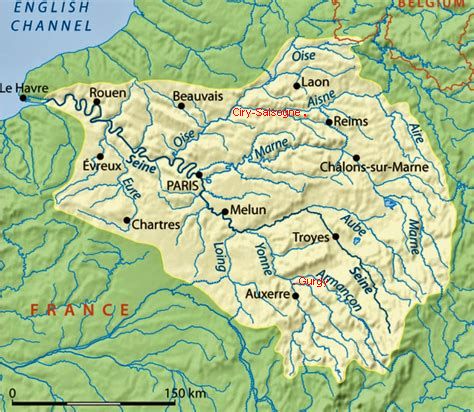 The Paris Basin is a large geological depression with the French capital at its center. It is encased by the Hercynian massifs of the Massif Armoricain (i.e. Brittany) to the west, the Massif Central to the south, the Vosges to the east and the Ardenne to the northeast. The drainage system, a determining factor in the patterns of communication and settlement, is dominated by the Seine in the north and the Loire in the south, and their tributaries, flowing in a northwesterly direction toward the English Channel and the Bay of Biscay respectively . . . Interaction, represented by imported bronze artifacts, between southern and eastern Europe on the one hand and the Paris Basin on the other, can be traced back to the final stages of the Late Bronze Age. - from "Early Iron Age Luxury Imports" by Nicholas Freidin, Expedition Magazine 24.3 (1982).
The Paris Basin is a large geological depression with the French capital at its center. It is encased by the Hercynian massifs of the Massif Armoricain (i.e. Brittany) to the west, the Massif Central to the south, the Vosges to the east and the Ardenne to the northeast. The drainage system, a determining factor in the patterns of communication and settlement, is dominated by the Seine in the north and the Loire in the south, and their tributaries, flowing in a northwesterly direction toward the English Channel and the Bay of Biscay respectively . . . Interaction, represented by imported bronze artifacts, between southern and eastern Europe on the one hand and the Paris Basin on the other, can be traced back to the final stages of the Late Bronze Age. - from "Early Iron Age Luxury Imports" by Nicholas Freidin, Expedition Magazine 24.3 (1982).
The town of Gurgy is on the Yonne river, a tributary of the Seine, at the south eastern end of the Paris Basin. It is just north of Auxerre. "Les Noisats" is the name given to the Early/Middle Neolithic necropolis unearthed there. The site provided the first evidence of Early Farmers in this region. The DNA samples taken from the Neolithic remains at Gurgy (all ancestor types to my own) were,
Y-DNA & Date (if determined)Note that these are central European G2a samples, that is Linear Pottery culture. The G-M406 type which defined Early Farmer migration through the Mediterranean and up the Rhone, was G2a2b1. It was part of the Cardial Pottery culture. While we might expect Gurgy to be a mixing point for those two cultures, it apparently was not. Those G2a samples taken at Fleury-sur-Orne in Calvados, Normandy were all G2a2a. The seven samples taken from a mass grave in Halberstadt, Saxony-Anhalt, Germany were varities of G2a2a and G2a2b. These are suspected to be the remains of a non-local group that attacked the settlement, were defeated, and then executed. Note that the 'regular' burials in Halberstadt were also G2a2, so apparently this was two farmer communities warring on each other.
G2a2b2a1 [L140]
G2a2b2a1 [L140]
G2a2b2a1 [L140] 4539-4367 BC
G2a2b2a1 [L140]
H2
G2a2b2a [P303]
G2a2b2a1 [L140] 4829-4623 BC
G2a2b2a [P303]
H2
G2a2b2a [P303]
G2a2b2a1 [L140]
G2a2b2a1a [PF3346]
G2a2b2a1 [L140] 4784-4546 BC
Another Paris Basin gravesite, Ciry-Salsogne, cited above, contains Bell Beaker remains, probably those of the middle or lower Rhine, i.e. Rhenish Beakers.
Below is my best guess on how our family haplogroup got to northern England. I'll start with the family located in the northern Fertile Crescent, near where the G type probably originated. Early in the Neolithic a G2a subgroup moved west to the Konya plain of Anatolia, to the cities of Boncuklu Hoyuk and Catal Hoyuk. From there they later migrated northwest to the city of Barcin Hoyuk, near the shore of the Sea of Marmara, where ancient evidence of haplogroup G2a2b2a1a has been found. I then trace that haplogroup into Europe and on into northern Bulgaria, near the course of the Danube river. Next the family followed the Danube river west and north into the Hungarian plain. Note that both the Bulgarian and Hungarian G2a2b2a1a samples were found at sites on that river. From Bulgaria, still following the Danube, an offshoot of the haplogroup was found in Austria, just north of Vienna. After that they would have gone further west to where the headwaters of the Danube and Rhine rivers meet. It is here that the haplogroup is most commonly found today in Europe, in southwestern Germany, the Tyrol and Switzerland. Later, after the Bronze Age 'invasion' of the R1a/R1b haplogroup, the family was absorbed into the Bell Beaker Culture of the Rhineland and migrated into Britain in the mid-3rd millenium BC. They may have settled in East Yorkshire where many Bell Beaker burials have been found. Later they dispersed through northern England, perhaps pushed north and west by later arriving Celts, Romans, Angles, Saxons, and Vikings.
